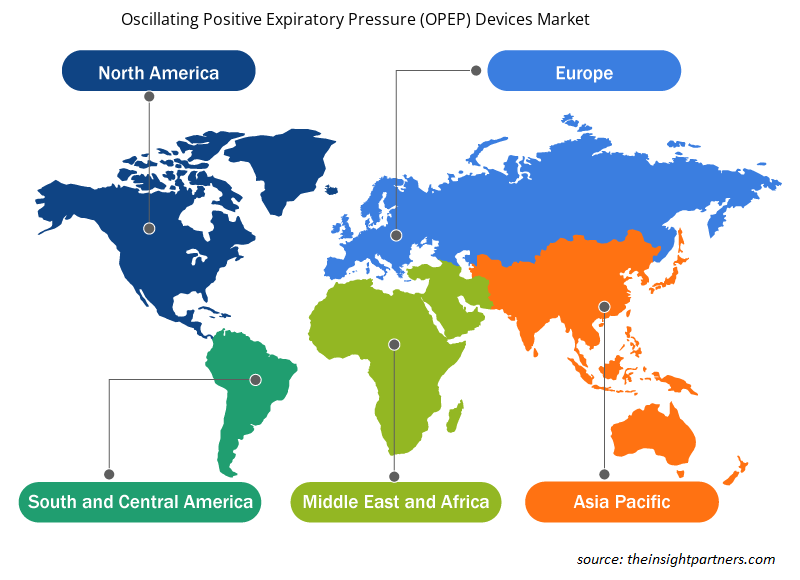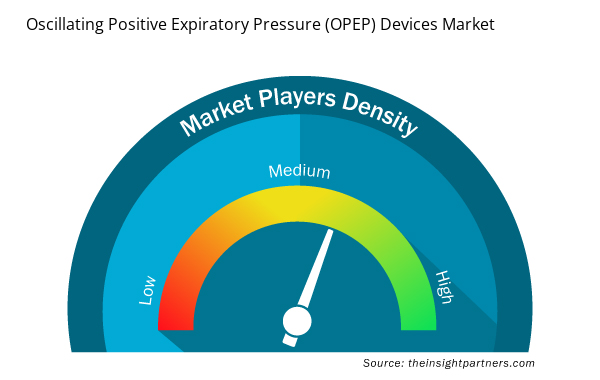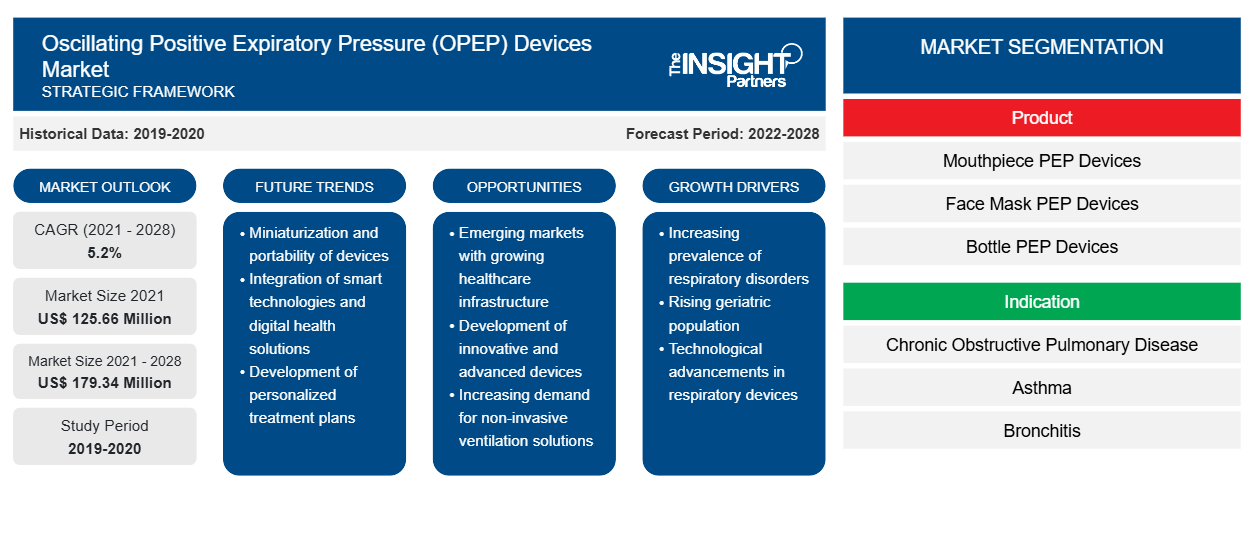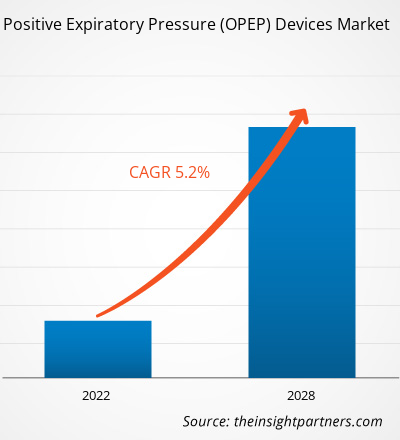振荡呼气正压 (OPEP) 设备市场预计将从 2021 年的 1.2566 亿美元增长到 2028 年的 1.7934 亿美元;预计 2021-2028 年期间的复合年增长率为 5.2%。
振荡呼气正压 (OPEP) 装置一直被用作传统胸部物理治疗 (CPT) 的补充,帮助无法咳嗽的人(尤其是患有慢性疾病的人)清除呼吸道分泌物。OPEP 装置在慢性气道疾病(如囊性纤维化、支气管扩张、支气管炎、支气管哮喘和原发性纤毛运动障碍综合征)中的应用仍然有限。在慢性阻塞性肺病 (COPD) 中,振荡呼气正压 (OPEP) 装置有助于痰液清除。
振荡正压呼气 (OPEP) 设备市场的增长归因于慢性阻塞性肺病 (COPD) 和哮喘的日益流行以及医疗技术的进步。然而,人们对 OPEP 设备的认知度低和使用受限阻碍了市场的增长。
定制此报告以满足您的需求
您可以免费定制任何报告,包括本报告的部分内容、国家级分析、Excel 数据包,以及为初创企业和大学提供优惠和折扣
- 获取此报告的关键市场趋势。这个免费样品将包括数据分析,从市场趋势到估计和预测。
市场洞察
慢性阻塞性肺病 (COPD) 和哮喘的患病率不断上升,推动市场增长
慢性阻塞性肺病 (COPD) 和囊性纤维化的发病率在世界范围内呈上升趋势。根据世界卫生组织 (WHO) 的数据,慢性阻塞性肺病 (COPD) 恶化是关键事件。与 COPD 相关的残疾和死亡推动了对 OPEP 设备的需求。根据疾病控制和预防中心 (CDC) 的数据,2018 年约有 900 万成年人被诊断出患有慢性支气管炎。此外,哮喘在所有年龄、性别和种族的人群中都变得越来越普遍。根据 CDC 的数据,全球约有 3 亿人患有哮喘,预计到 2025 年将增加 1 亿。哮喘的患病率、严重程度和死亡率在美国各地差异很大。哮喘影响了美国超过 2500 万人,相当于 7.7% 的成年人和 8.4% 的儿童。根据新西兰奥克兰的《2018 年全球哮喘报告》,按残疾调整生命年计算,哮喘在导致残疾的最大原因中排名第 16 位,在导致疾病负担的最大原因中排名第 28 位。哮喘在高收入国家很常见,而大多数与哮喘相关的死亡发生在低收入和中等收入国家。因此,慢性阻塞性肺病和哮喘患病率的上升推动了对粘液清除设备(如 OPEP 设备)的需求,从而促进了振荡呼气正压 (OPEP) 设备市场的增长。
基于产品的洞察
根据产品,振荡呼气正压 (OPEP) 设备市场细分为口含式 PEP 设备、面罩式 PEP 设备和瓶装 PEP 设备。口含式 PEP 设备部分在 2021 年占据了最大的市场份额。此外,预计在预测期内,该设备的市场复合年增长率将达到 5.3%。口含式 PEP 有助于清除肺部粘液。它还可以防止肺塌陷或打开塌陷的区域。推动口含式 PEP 设备市场发展的关键因素之一是老龄人口的增长,以及慢性阻塞性肺病 (COPD)和哮喘等慢性疾病的发病率上升。根据美国疾病控制和预防中心 (CDC) 的数据,到 2020 年,将有约 900 万人被诊断出患有慢性支气管炎,从而推动对口含式设备的需求。
指示见解
根据适应症,振荡呼气正压 (OPEP) 设备市场细分为慢性阻塞性肺病 (COPD)、哮喘、支气管炎、支气管扩张、囊性纤维化等。COPD 细分市场在 2021 年占据了最大的市场份额。然而,哮喘细分市场预计在预测期内的复合年增长率为 6.0%。COPD 是一种常见且可治疗的疾病,其特征是进行性气流受限和组织破坏。它与因长期接触有害颗粒或气体(最常见的是香烟烟雾)而导致的慢性炎症引起的结构性肺部变化有关。慢性炎症会导致气道变窄和肺回弹力减弱。
产品发布和批准是公司扩大其全球足迹和产品组合的常用策略。此外,振荡正压呼气 (OPEP) 设备市场参与者专注于合作战略以扩大其客户群,这反过来又使他们能够在全球范围内保持其品牌名称。由于市场参与者开发创新产品,预计未来几年市场将蓬勃发展。
振荡呼气正压装置
振荡呼气正压 (OPEP) 设备市场区域洞察
Insight Partners 的分析师已详尽解释了预测期内影响振荡呼气正压 (OPEP) 设备市场的区域趋势和因素。本节还讨论了北美、欧洲、亚太地区、中东和非洲以及南美和中美洲的振荡呼气正压 (OPEP) 设备市场细分和地理位置。

- 获取振荡呼气正压 (OPEP) 设备市场的区域特定数据
振荡呼气正压 (OPEP) 设备市场报告范围
| 报告属性 | 细节 |
|---|---|
| 2021 年市场规模 | 1.2566亿美元 |
| 2028 年市场规模 | 1.7934亿美元 |
| 全球复合年增长率(2021 - 2028) | 5.2% |
| 史料 | 2019-2020 |
| 预测期 | 2022-2028 |
| 涵盖的领域 | 按产品
|
| 覆盖地区和国家 | 北美
|
| 市场领导者和主要公司简介 |
|
振荡呼气正压 (OPEP) 设备市场参与者密度:了解其对业务动态的影响
振荡正压呼气 (OPEP) 设备市场正在快速增长,这得益于终端用户需求的不断增长,而这些需求又源于消费者偏好的不断变化、技术进步以及对产品优势的认识不断提高等因素。随着需求的增加,企业正在扩大其产品范围,进行创新以满足消费者的需求,并利用新兴趋势,从而进一步推动市场增长。
市场参与者密度是指在特定市场或行业内运营的企业或公司的分布情况。它表明在给定市场空间中,相对于其规模或总市场价值,有多少竞争对手(市场参与者)存在。
在振荡呼气正压 (OPEP) 设备市场运营的主要公司有:
- 艾尔建公司(Allergan Plc)
- 帕里有限公司
- 史密斯医疗
- 空气物理
- 德
免责声明:上面列出的公司没有按照任何特定顺序排列。

- 获取振荡呼气正压 (OPEP) 设备市场顶级关键参与者概览
公司简介
- 艾尔建公司(Allergan Plc)
- 帕里有限公司
- 史密斯医疗
- 空气物理
- D•R 伯顿医疗保健
- Medica 控股有限公司
- CEGLA Medizintechnik GmbH & Co. KG
- 健保医疗
- 特鲁德尔医疗国际公司
- 水星医疗
- 历史分析(2 年)、基准年、预测(7 年)及复合年增长率
- PEST 和 SWOT 分析
- 市场规模价值/数量 - 全球、区域、国家
- 行业和竞争格局
- Excel 数据集


- Print Management Software Market
- Dealer Management System Market
- Water Pipeline Leak Detection System Market
- Photo Editing Software Market
- Automotive Fabric Market
- Vaginal Specula Market
- Adaptive Traffic Control System Market
- Biopharmaceutical Tubing Market
- Energy Recovery Ventilator Market
- EMC Testing Market

Report Coverage
Revenue forecast, Company Analysis, Industry landscape, Growth factors, and Trends

Segment Covered
This text is related
to segments covered.

Regional Scope
North America, Europe, Asia Pacific, Middle East & Africa, South & Central America

Country Scope
This text is related
to country scope.
常见问题
COVID-19 was more likely to hospitalize those with moderate-to-severe or uncontrolled asthma. The coronavirus can cause pneumonia, blood clots, and acute respiratory distress syndrome, among other lung issues. The epidemic has added new levels of anxiety for both patients and clinicians for the nearly 37 million Americans who live with a chronic lung illness like asthma or chronic obstructive pulmonary disease. Caring for people with COVID-19 and underlying COPD is very difficult at this time. Certain treatments for COPD patients, such as nebulized bronchodilators and non-invasive ventilation (NIV), are thought to enhance the risk of viral transmission via aerosols. Although oscillating positive expiratory pressure (OPEP) devices have been in use with the increasing cases of COVID-19 in the region as studies shows oscillating positive expiratory pressure (OPEP) devices results in minimizing the effect of respiratory distress due to COVID. Also, the Positive Expiratory Pressure (PEP) flute therapy and Positive End-Expiratory Pressure (PEEP) proved to be led to a small yet statistically significant decrease in the severity of respiratory symptoms in adults with COVID-19 recovering at home as per various research studies.
North America held the largest share of the oscillating positive expiratory pressure (OPEP) devices market and is expected to continue its position over the coming years. These oscillating positive expiratory pressure (OPEP) devices are in high demand in North America's regional segment. Furthermore, the presence of a robust medical infrastructure and the early availability of new products and equipment are aiding the area market's overall development.
Trudell Medical International and Allergan Plc are the top two companies that hold huge market shares in the Oscillating Positive Expiratory Pressure (OPEP) Devices market.
The Oscillating Positive Expiratory Pressure (OPEP) Devices market majorly consists of players such as Allergan Plc.; PARI GmbH; Smiths Medical; AirPhysio; D•R BURTON HEALTHCARE; Medica Holdings, LLC; CEGLA Medizintechnik GmbH & Co. KG; Able Healthcare; Trudell Medical International; Mercury Medical amongst others.
The hospital pharmacies segment dominated the global oscillating positive expiratory pressure (OPEP) devices market and accounted for the largest market share of 60.48% in 2021.
The mouthpiece PEP devices segment held the largest share of the market in the global oscillating positive expiratory pressure (OPEP) devices market and held the largest market share of 94.68% in 2021.
The chronic obstructive pulmonary disease (COPD) segment dominated the global oscillating positive expiratory pressure (OPEP) devices market and accounted for the largest market share of 34.60% in 2021.
Oscillatory positive expiratory pressure (OPEP) devices have been used as a supplement to traditional chest physiotherapy (CPT) to aid in the clearing of respiratory secretions in people who can't cough, especially those with chronic conditions. In chronic airway disorders such as cystic fibrosis, bronchiectasis, bronchitis, bronchial asthma, and primary ciliary dyskinesia syndrome, the usage of OPEP devices is still limited. In chronic obstructive pulmonary disease (COPD), oscillating positive expiratory pressure (OPEP) devices are said to help with sputum clearance.
Key factors that are driving the growth of this market are the growing prevalence of chronic obstructive pulmonary disease (COPD) and asthma, and rising technological advancements are expected to boost the market growth for oscillating positive expiratory pressure (OPEP) devices over the years.
The CAGR value of the oscillating positive expiratory pressure (OPEP) devices market during the forecasted period of 2021–2028 is 5.2%.
Trends and growth analysis reports related to Life Sciences : READ MORE..
The List of Companies - Oscillating Positive Expiratory Pressure (OPEP) Devices Market
- Allergan Plc.
- PARI GmbH
- Smiths Medical
- AirPhysio
- D•R BURTON HEALTHCARE
- Medica Holdings, LLC
- CEGLA Medizintechnik GmbH & Co. KG
- Able Healthcare
- Trudell Medical International
- Mercury Medical
The Insight Partners performs research in 4 major stages: Data Collection & Secondary Research, Primary Research, Data Analysis and Data Triangulation & Final Review.
- Data Collection and Secondary Research:
As a market research and consulting firm operating from a decade, we have published and advised several client across the globe. First step for any study will start with an assessment of currently available data and insights from existing reports. Further, historical and current market information is collected from Investor Presentations, Annual Reports, SEC Filings, etc., and other information related to company’s performance and market positioning are gathered from Paid Databases (Factiva, Hoovers, and Reuters) and various other publications available in public domain.
Several associations trade associates, technical forums, institutes, societies and organization are accessed to gain technical as well as market related insights through their publications such as research papers, blogs and press releases related to the studies are referred to get cues about the market. Further, white papers, journals, magazines, and other news articles published in last 3 years are scrutinized and analyzed to understand the current market trends.
- Primary Research:
The primarily interview analysis comprise of data obtained from industry participants interview and answers to survey questions gathered by in-house primary team.
For primary research, interviews are conducted with industry experts/CEOs/Marketing Managers/VPs/Subject Matter Experts from both demand and supply side to get a 360-degree view of the market. The primary team conducts several interviews based on the complexity of the markets to understand the various market trends and dynamics which makes research more credible and precise.
A typical research interview fulfils the following functions:
- Provides first-hand information on the market size, market trends, growth trends, competitive landscape, and outlook
- Validates and strengthens in-house secondary research findings
- Develops the analysis team’s expertise and market understanding
Primary research involves email interactions and telephone interviews for each market, category, segment, and sub-segment across geographies. The participants who typically take part in such a process include, but are not limited to:
- Industry participants: VPs, business development managers, market intelligence managers and national sales managers
- Outside experts: Valuation experts, research analysts and key opinion leaders specializing in the electronics and semiconductor industry.
Below is the breakup of our primary respondents by company, designation, and region:

Once we receive the confirmation from primary research sources or primary respondents, we finalize the base year market estimation and forecast the data as per the macroeconomic and microeconomic factors assessed during data collection.
- Data Analysis:
Once data is validated through both secondary as well as primary respondents, we finalize the market estimations by hypothesis formulation and factor analysis at regional and country level.
- Macro-Economic Factor Analysis:
We analyse macroeconomic indicators such the gross domestic product (GDP), increase in the demand for goods and services across industries, technological advancement, regional economic growth, governmental policies, the influence of COVID-19, PEST analysis, and other aspects. This analysis aids in setting benchmarks for various nations/regions and approximating market splits. Additionally, the general trend of the aforementioned components aid in determining the market's development possibilities.
- Country Level Data:
Various factors that are especially aligned to the country are taken into account to determine the market size for a certain area and country, including the presence of vendors, such as headquarters and offices, the country's GDP, demand patterns, and industry growth. To comprehend the market dynamics for the nation, a number of growth variables, inhibitors, application areas, and current market trends are researched. The aforementioned elements aid in determining the country's overall market's growth potential.
- Company Profile:
The “Table of Contents” is formulated by listing and analyzing more than 25 - 30 companies operating in the market ecosystem across geographies. However, we profile only 10 companies as a standard practice in our syndicate reports. These 10 companies comprise leading, emerging, and regional players. Nonetheless, our analysis is not restricted to the 10 listed companies, we also analyze other companies present in the market to develop a holistic view and understand the prevailing trends. The “Company Profiles” section in the report covers key facts, business description, products & services, financial information, SWOT analysis, and key developments. The financial information presented is extracted from the annual reports and official documents of the publicly listed companies. Upon collecting the information for the sections of respective companies, we verify them via various primary sources and then compile the data in respective company profiles. The company level information helps us in deriving the base number as well as in forecasting the market size.
- Developing Base Number:
Aggregation of sales statistics (2020-2022) and macro-economic factor, and other secondary and primary research insights are utilized to arrive at base number and related market shares for 2022. The data gaps are identified in this step and relevant market data is analyzed, collected from paid primary interviews or databases. On finalizing the base year market size, forecasts are developed on the basis of macro-economic, industry and market growth factors and company level analysis.
- Data Triangulation and Final Review:
The market findings and base year market size calculations are validated from supply as well as demand side. Demand side validations are based on macro-economic factor analysis and benchmarks for respective regions and countries. In case of supply side validations, revenues of major companies are estimated (in case not available) based on industry benchmark, approximate number of employees, product portfolio, and primary interviews revenues are gathered. Further revenue from target product/service segment is assessed to avoid overshooting of market statistics. In case of heavy deviations between supply and demand side values, all thes steps are repeated to achieve synchronization.
We follow an iterative model, wherein we share our research findings with Subject Matter Experts (SME’s) and Key Opinion Leaders (KOLs) until consensus view of the market is not formulated – this model negates any drastic deviation in the opinions of experts. Only validated and universally acceptable research findings are quoted in our reports.
We have important check points that we use to validate our research findings – which we call – data triangulation, where we validate the information, we generate from secondary sources with primary interviews and then we re-validate with our internal data bases and Subject matter experts. This comprehensive model enables us to deliver high quality, reliable data in shortest possible time.


 获取此报告的免费样本
获取此报告的免费样本